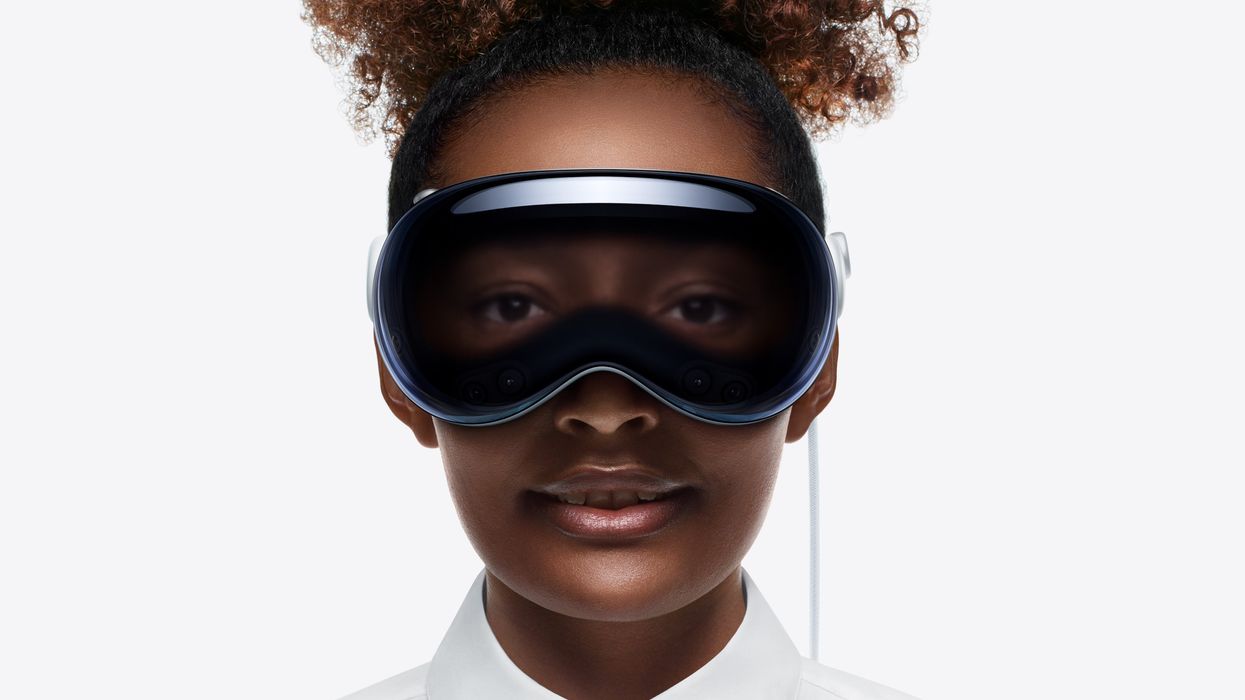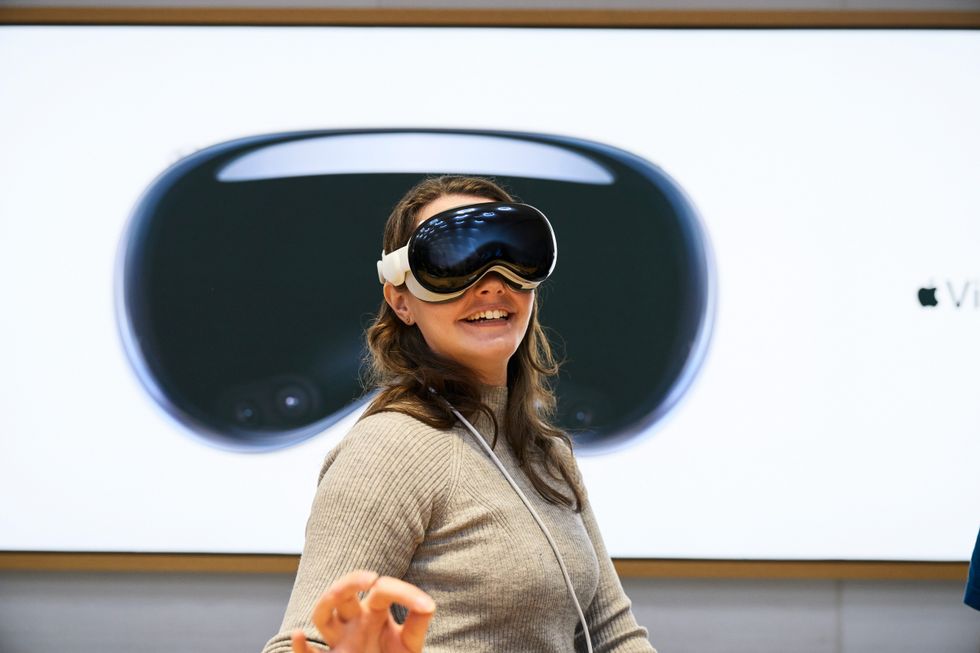
Image courtesy of Apple Newsroom

The Vision Pro is Apple’s long-awaited reality-warping headset, shipping now for the nominal fee of $3,499. Despite that eye-watering price, the product is a hit — Apple sold 200,000 of these things before they even hit store shelves.
Of course, there was never any doubt that if a company could bring the virtual reality headset to the masses, it would be Apple. While VR is not a new technology — clunky consumer products date back to the early 1990s — it’s seen a renaissance in the past few years, largely thanks to steep investment and marketing muscle from Meta (née Facebook), which purchased the technology in 2014.
And that’s why the Vision Pro is a looming disaster for the human race. With Vision Pro, ignoring reality is as simple as turning a knob.
While the Oculus Quest headsets have been an enormous hit, they’ve never entirely made it past the nerdy novelty zone. They’re a neat toy you get your kids for Christmas. They obsess over it for a few weeks or months, and it promptly gets lost in a drawer, never to be seen again.
This category of hype product Apple excels at. Personal computers, MP3 players, smartphones, and smartwatches were all once clunky nerd novelties until Apple scooped them up, applied its je ne sais quoi, and re-released them as mass-market sensations. Apple has a knack for making the nerdy hip.
While the first iteration of the Vision Pro — which resembles a pair of ski goggles — is expensive, dorky, and not quite fully baked, there’s little doubt that the company will figure it out as time goes on, just as it did with the Apple Watch, which became ubiquitous after an awkward launch. The price will come down, Apple will convince you that wearing ski goggles in public is cool, and next thing you know, the Vision Pro 4 will be a must-have to function in polite society.
And that’s why the Vision Pro is a looming disaster for the human race.
With Vision Pro, ignoring reality is as simple as turning a knob.
The term “mixed reality” should be a red flag. Our reality is already mixed enough, with people barely able to tell fantasy from reality, largely thanks to Apple’s iPhone, which began innocuous enough and soon became the lens by which everyone views — and shares their view of — the world. And those views often become warped, thanks to technologies like face filters, which can make you look a different age, gender, race, or even species.
As the “Pro” title indicates, Apple is positioning the Vision Pro as a serious work device instead of a futuristic toy. Apple wants the Vision Pro to be taken seriously. But let’s be honest: Games and amusements will significantly influence Vision Pro’s popularity. The masses aren’t going to pick these up to work on spreadsheets.

Let’s be blunt for a second. Despite all the bluster and hype around spatial computing and virtual workspaces, the Vision Pro is a high-tech hallucination machine. Even in its benign form, it closes you off from the real world to trick your brain into thinking that a spreadsheet is floating in your living room.
Consider how many of us already shut out the outside world to stare into the black mirror of our phones. We often ignore our spouses, children, and friends to gaze into the distorted world of social media, where everyone is playing some sort of character, whether it’s a political extremist or a guy whose entire schtick is based around eating raw organs. The longer we remain in the social media world, the more outlandish and extreme everyone gets because we no longer interact with each other as people but as blank screens upon which we project warped caricatures.
At least, for the moment, you can put down the phone and walk away. Soon, that may not be so easy. If and when technology like the Vision Pro becomes mainstream, we may soon find ourselves in a constant haze of digital hallucination.
Apple’s marketing does nothing to dissuade this. In its latest Vision Pro ad, dubbed “First-Timer,” a man watches a movie alone in total isolation.
First-Timer | Apple Vision Pro www.youtube.com
To be fair to Apple, it’s attempting to make an inherently antisocial technology less so. When people approach you in an immersive environment, they break through as if from a fog. The front display also shows a simulacrum of your eyes through a technology Apple calls EyeSight, though the effect is more creepy than welcoming.
However, these feel like half-measures designed to help make an inherently icky technology more palatable. We’ve lived in the iPhone world long enough to observe ourselves and others often hopelessly lost in their phones. Once we remove the simple option of looking up, it will be game over.
Apple has been working on reality-warping technology for years, though it’s being very cautious about rolling it out for the Vision Pro. One such technology is Animojis, introduced with iOS 11 in 2017, which lets you replace your face with a cartoon image of things like cats, robots, and unicorns. Apple followed up the next year with Memojis, which are customizable avatars.
It’s not inconceivable that soon, you’ll be able to replace people’s heads and faces with the ones you choose. Think your spouse is ugly? Give him or her a new face! Would you prefer to identify as a werewolf? Entirely possible. And it’s also very possible that Vision Pro users will grow so used to such a warped world that the non-enhanced world will seem ugly, disorienting, and dysphoric.
Apple Shows Off New 'Memoji' Feature www.youtube.com
You can already use the Vision Pro to get lost in your memories. The iPhone 15 Pro and the Vision Pro both can take 3D “spatial” photos and videos, which you can then relive forever in full 3D in the Vision Pro.
However, we have yet to discuss Vision Pro’s strangest feature.
You can make and receive FaceTime calls with the Vision Pro, and you may be wondering how that works when there’s no way to have a camera pointed on your face. Apple has a humdinger of a solution, and it may be the creepiest aspect of the Vision Pro: The Vision Pro scans your face to make a 3D re-creation of it called a Persona. Personas are used instead of your face for Vision Pro FaceTime calls. The Persona is also used to represent your eyes on the device’s EyeSight display.
The Vision Pro is an inherently anti-human technology. It fundamentally closes humans off from other humans. It peppers your sense of reality with illusions and digital hallucinations. It can even replace you entirely.
So a loved one could be talking to you, either in person or over FaceTime, and not actually talking to you but to a digital doppelgänger you animate. Right now, no one will be fooled: the Personas look (probably intentionally) blurry and weird.
However responsible Apple may try to be with the technology, it has chilling implications. It’s already possible to “resurrect” someone with a large language model (like ChatGPT) if you can feed the model enough of the person's writing. It’s also possible to re-create someone’s voice with AI. With face-scanning technology, it’ll soon be entirely possible to replicate a person digitally.
Many reading this will think I’m alarmist, but most of us didn’t recognize the earth-shattering potential of the original iPhone. Some saw it as the future, others saw it as an overpriced toy, but almost no one envisioned how it would spark revolutions and protests or change the way we date, shop, and interact with each other. Would there be “cancel culture” without the iPhone? Would the COVID panopticon have been possible? Would OnlyFans be a thing? The iPhone has changed nearly every aspect of our lives and our culture, and we haven’t even had time to assess to what degree.
The Vision Pro is an inherently anti-human technology. It fundamentally closes humans off from other humans. It peppers your sense of reality with illusions and digital hallucinations. It can even replace you entirely.
Personally, I hope it’s a big, expensive failure for Apple. I find solace in the fact that while cell phones were already incredibly popular before the iPhone arrived, nerd goggles have yet to really take off over the past 30 years they’ve tried. Let’s hope it stays that way.
- YouTube youtu.be
Josh Centers